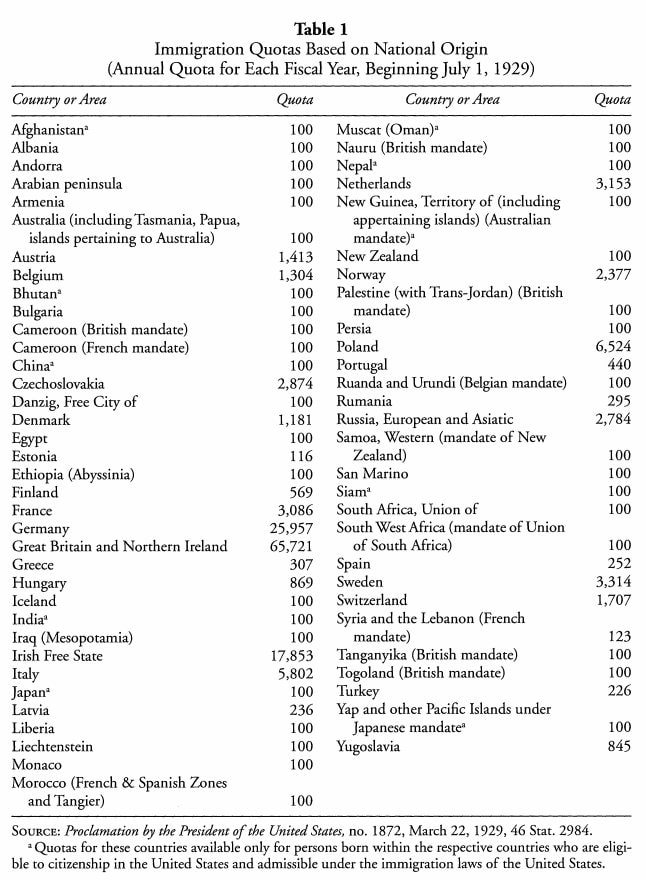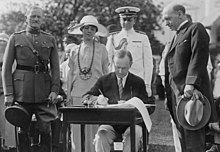Overview
Following the end of World War I, The United States had adopted an isolationist mindset in regards to international affairs. This meant that the U.S. government would aim to strengthen its borders and focus more on domestic matters than getting involved in the businesses of Europe. While fears of Communism in the East were spreading across the country, immigration became a major issue for Americans. The Johnson-Reed Immigration Act was a response to the increased hostility towards immigrants and is a document which placed numerical restrictions on immigration from certain countries along with establishing what we know today as the Visa process in order to legally reside in the country.
Before the Act
Prior to the Immigration Act being passed by Congress, it is important to understand how the United States was experiencing immigration and what attitudes towards immigrants were. Throughout the late 19th century and early 20th century the U.S. experienced a wave of immigration, largely in cities where unskilled labor work was readily available. In 1917 Congress passed one of its first restrictive laws on immigration that included a literacy test to be performed before entering the country, it increased taxes for new immigrants and gave more power to border officials on who should and should not enter the United States. The 1917 act also excluded all immigrants from anyone born in Asia, except Japan and the Philippines.

Despite the U.S. government establishing new barriers to limit immigration numbers, the 1917 act was not enough to prevent new immigrants from entering the country. It was during the 1920s that the idea of implementing quotas was brought up as a method in which immigration could be hindered. Republican Senator William P. Dillingham introduced action of setting a three percent rule on all forign born citizens of the United States. This would mean that passed on the percentages taken from the previous census, only a specific number of Visas would be granted for each country. Dillingham’s policy was established in 1922 and would continue to be praised until 1924 when the Johnson-Reed Act made some changes to the quota system that greatly shifted the narrative of immigration for the following decades.
The Immigration Act of 1924

So what changed in 1924? While the major point of using a quota system to limit immigration remained intact, there were some changes regarding exactly how many of each ethnicity was allowed into the U.S. Another change was that the previous measure from 1917 that excluded immigration from the far East and Asia would now include immigrants from Japan.
As a result of increasing the calculations of Americans of British descent, the quotas for The United Kingdom and other countries in Western Europe increased, while Southern and Eastern European countries saw a decrease in available Visas. In the act there are dramatic jumps between countries such as Greece who have a 307 immigrant quota restriction and Germany who has an allowed quota of 25,957. These differences not only restricted the overall number of immigrants coming from those countries, but also who was most likely to be granted citizenship. In countries with severely restricted quotas such as Egypt(100), Armenia(100), Turkey(226) those of higher status and more educated would be more likely to gain one of the allotted hundred spots available. The disproportions of the quotas highlighted the racialized system of achieving citizenship in the U.S. Through the law nationality was able to remain designated for white Europeans who fit in with Western values.

Japan
The Immigration Act of 1924 greatly angered the Japanese. This is because in 1907 the Japanese government had made an agreement with then president Theodore Roosevelt which included an increased quota for Japan given that the country makes an effort to restrict its own citizens from leaving. Yet the 1924 act neglected the agreement in favor of severe restrictions at a loss to Japan, causing the Japanese government to lose respect for American leadership.
Public Perception
In general the American public was pretty split on the issue of Immigration during the 1920s. While many naturalized citizens supported the act as they believed their job opportunities had dwindled due to new immigrants, there were also those who felt that the principals on which America was founded upon were being thrown away. World War I had a great impact on identity politics and increased nationalism within the U.S., making something like the Johnson-Reed Act appear to be in favor of maintaining America’s national identity. Fear of the “other” coming from Communist Eastern Europe or Asia caused many to support a more restrictive policy on who was able to enter the country.
There was this idea that immigrants from the South or East would have a more difficult time adjusting to American customs and way of life. There was also the belief that they would bring unfamiliar traditions or traits into American society. There was an increased stigma about anyone from countries with a predominantly Jewish or Muslim population and those with starkly different racialized features that stood out against the white majority.
Mapping the Johnson-Reed Immigration Act
The 1920s
The Johnson-Reed Immigration Act of 1924 is a product of its decade and a result of the uncertainty many felt as they entered into the 20th century. While many Americans supported the act in favor of an isolationist mindset, the act is a reminder of how immigration policies are reflective of the society that makes them. Despite the artistic and technological revolutions of the 1920s, there was still incredible prejudice against immigrants from Asia, Eastern Europe, the Middle East and South America. The Immigration Act of 1924 is an example of how the United States government continued to look inward during the 1920s, instead of embracing the global landscape surrounding them. The restrictions placed during the decade have implications that continue to be felt in the 21st century as attitudes about Visa status and citizenship are continued to be debated along racial and ethnic lines.

Significance
The legacy of the Johnson-Reed Act can be seen in a heightened border security system and a more regulated Visa process. The ethnic makeup of the country is a direct result of immigration policies which allowed for increased quotas for Western European countries. It is also a foundation that sets a standard for who is deemed a greater asset to American society, and which group of people is undesired by the government. Although a bill like the Johnson-Reed Act could never be passed in 2021, discussions about physical walls and militarized border security have roots stemming from the immigration policy of the 1920s.
I chose this topic because I believe it is important to understand the lasting impact on historical policies and note how certain legal measures can still be felt today. As the world continues to grow more interconnected it is essential to reflect on how immigration policy impacts our views on certain cultures and ethnicities in order to move forward in favor of more inclusive measures that are not based on racial, political or xenophobic foundations.
Citations
Ngai, Mae M. “The Architecture of Race in American Immigration Law: A Reexamination of the Immigration Act of 1924.” The Journal of American History 86, no. 1 (1999): 67-92. Accessed April 19, 2021. https://www.jstor.org/stable/2567407
Ngai, Mae M. “Nationalism, Immigration Control, and the Ethnoracial Remapping of America in the 1920S.” OAH Magazine of History 21, no. 3 (2007): 11-15. Accessed April 19, 2021. http://www.jstor.org/stable/25162123.
Jaret, Charles. “Troubled by Newcomers: Anti-Immigrant Attitudes and Action during Two Eras of Mass Immigration to the United States.” Journal of American Ethnic History 18, no. 3 (1999): 9-39. Accessed April 19, 2021. http://www.jstor.org/stable/27502448.
Milestones: 1921- 1936: https://history.state.gov/milestones/1921-1936/immigration-act
Library of Congress: https://www.loc.gov/item/uscode1925-003008006/
President Calvin Coolidge signs into law the Immigration Act of 1924: https://www.history.com/this-day-in-history/coolidge-signs-stringent-immigration-law
The 1924 Law That Slammed the Door on Immigrants and the Politicians Who Pushed it Back Open: https://www.smithsonianmag.com/history/1924-law-slammed-door-immigrants-and-politicians-who-pushed-it-back-open-180974910/
Closing the Door on Immigration: https://www.nps.gov/articles/closing-the-door-on-immigration.htm
Senior History and American Studies student at Ramapo College of New Jersey enrolled in Discovering Digital History course taught by Dr. Hajo during Spring 2021.

